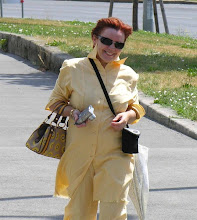I come back to the story of route which we began travel the last year. I’ll remind, the start point became Karlskirche, and today we still stayin’ Karlsplatz and stand in front of building of Secession. It is a difficult task to tell about Secession as the building itself and movement of Secession are described in every tourist guides and it’s real challenge for me.
I’ve looked through the photos took at different years and have chosen some ones that attached along with well-known views to my today’s post. First: “Mark-Anton Gruppe” situated on the right hand of Secession. The second: I’ll maintain my telling about Secession movement with some last year’s photos as illustration of close connection of generations living in different time. A little bit “hooligan” but continuing to break moral principles of society.
In spring 2010 the Exhibition by Christoph Büchel “Raum für Sexkultur“, was held in Secession. Artist represents an installation decorated as a room of Vienna Swinging Club. Unfortunately I returned to Vienna at the end of April and couldn’t visit it. I haven’t even chance to tell about as Secession official web site didn’t published the report yet and there is an announcement “coming soon” till now but nevertheless, there was something that remained about exhibition up to the autumn. In front of entrance niche there was an original poster and we can enter the building crossing (passing going) “between legs of the naked girl”.
Now, it is time to mention about Secession movement. It seems to me, that this remark will set all on the places and it will clear why similar exhibition are pertinent in Secession.
Vienna Secession was founded at the end of 19th century and the members of it were Gustav Klimt, Koloman Mozer, Joseph Maria Olbrich, Oskar Kokoshka, Egon Schile and other artists. I believe these names speak about much. Even who only saw movie “Klimt” can imagine an atmosphere and ideas of those years without effort. These artists have torn with traditional concepts of art and have created new association, which we name Vienna Secession since then. Approximately at the same time Joseph Maria Olbrich has designed exhibition pavilion Secession. Today the building of Secession named a key work of Viennese Art Nouveau. Everything was designed and made by group members and even decorative vases in front of entrance are the art objects.
It is getting clear now, why the “Mark Anton Gruppe” sculpture is situated on the right hand of Secession. Originally the sculptural group was established temporarily on this place and there are no any explanation inscriptions about this decision. The choice of place was hot debated and in result the sculpture was established near Secession temporarily (I remind, it was a time of active development of vacant territory of Karlsplatz) but the commission never discussed this question in future and we see “Mark Anton Gruppe” at the same place. The sculpture was created by Secession member of Arthur Strasser and probably this fact became the main reason of the choice of place near Secession. The Sculpture was created especially for a world’s fair in Paris, 1900.
Now, about Secession building a little. The building occupies the area 1000 m². Walls represent massive cubic blocks; however these rather rigid geometrical lines soften the curves indoors. The round dome is executed of 3000 gilded bronze laurel leaves (laurel leaf is the dominant symbol of building) and 700 round berries. The entrance area is decorated by the masks of the three Gorgons, which symbolize architecture, sculpture and painting. The motto of Secession movement is written above the entrance of the pavilion: “To every age its art, to art its freedom”. The building was damaged by bombs during WWII and set on fire by the retreating German army). Today we see renovated building of Secession.
(information about building and a photo of destroyed Secession from official web site of Secession).

































